Customer Relationship Management Strategies
VerifiedAdded on 2020/10/22
|17
|4816
|465
AI Summary
This assignment is a detailed analysis of customer relationship management (CRM) strategies, covering key concepts, theories, and practical applications. It includes an examination of CRM techniques in various industries, including hospitality and food service, and provides examples of successful CRM implementation. The assignment also explores the importance of emotional intelligence, experience-based service expectations, and co-creative perspectives in CRM.
Contribute Materials
Your contribution can guide someone’s learning journey. Share your
documents today.
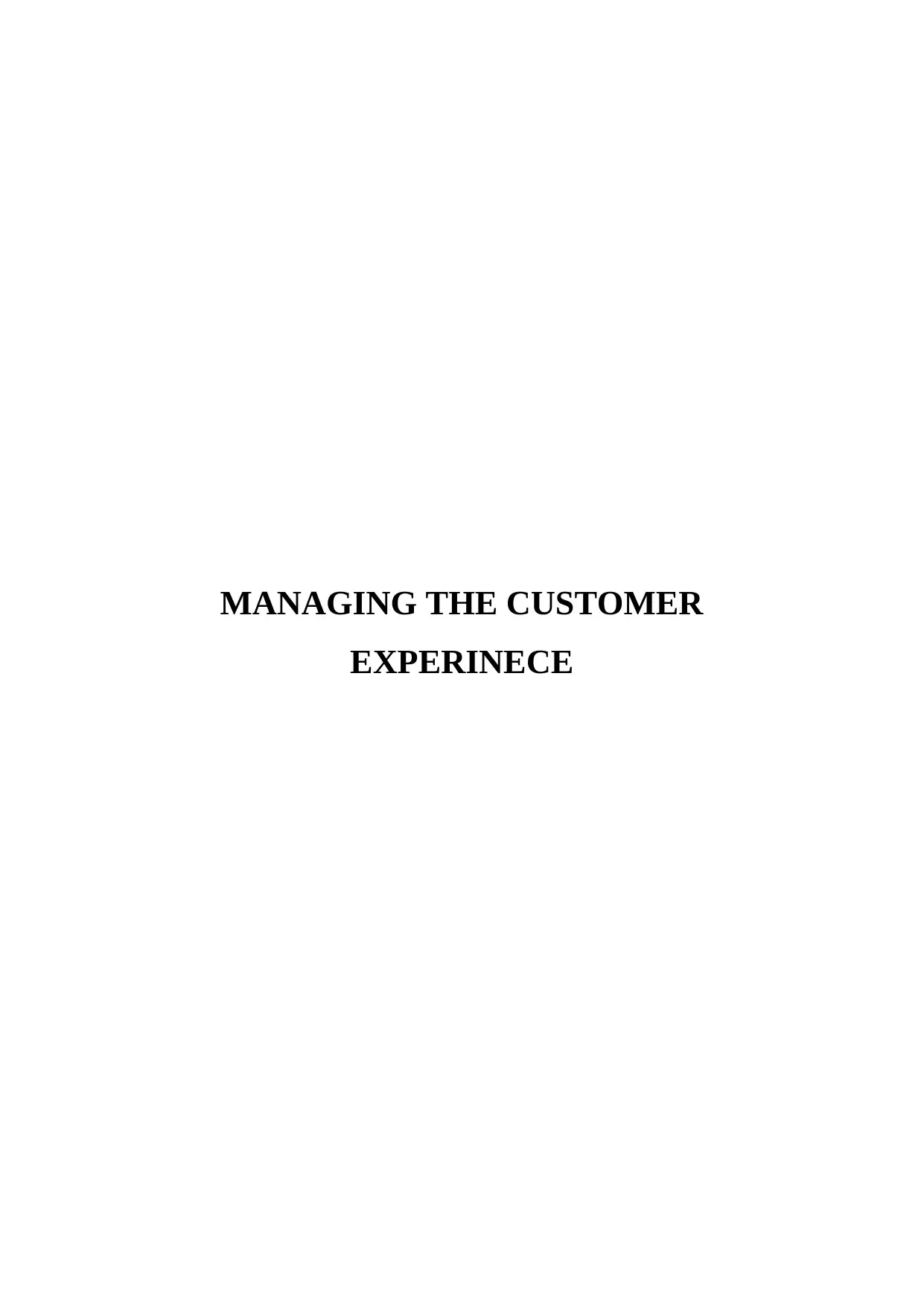
MANAGING THE CUSTOMER
EXPERINECE
EXPERINECE
Secure Best Marks with AI Grader
Need help grading? Try our AI Grader for instant feedback on your assignments.
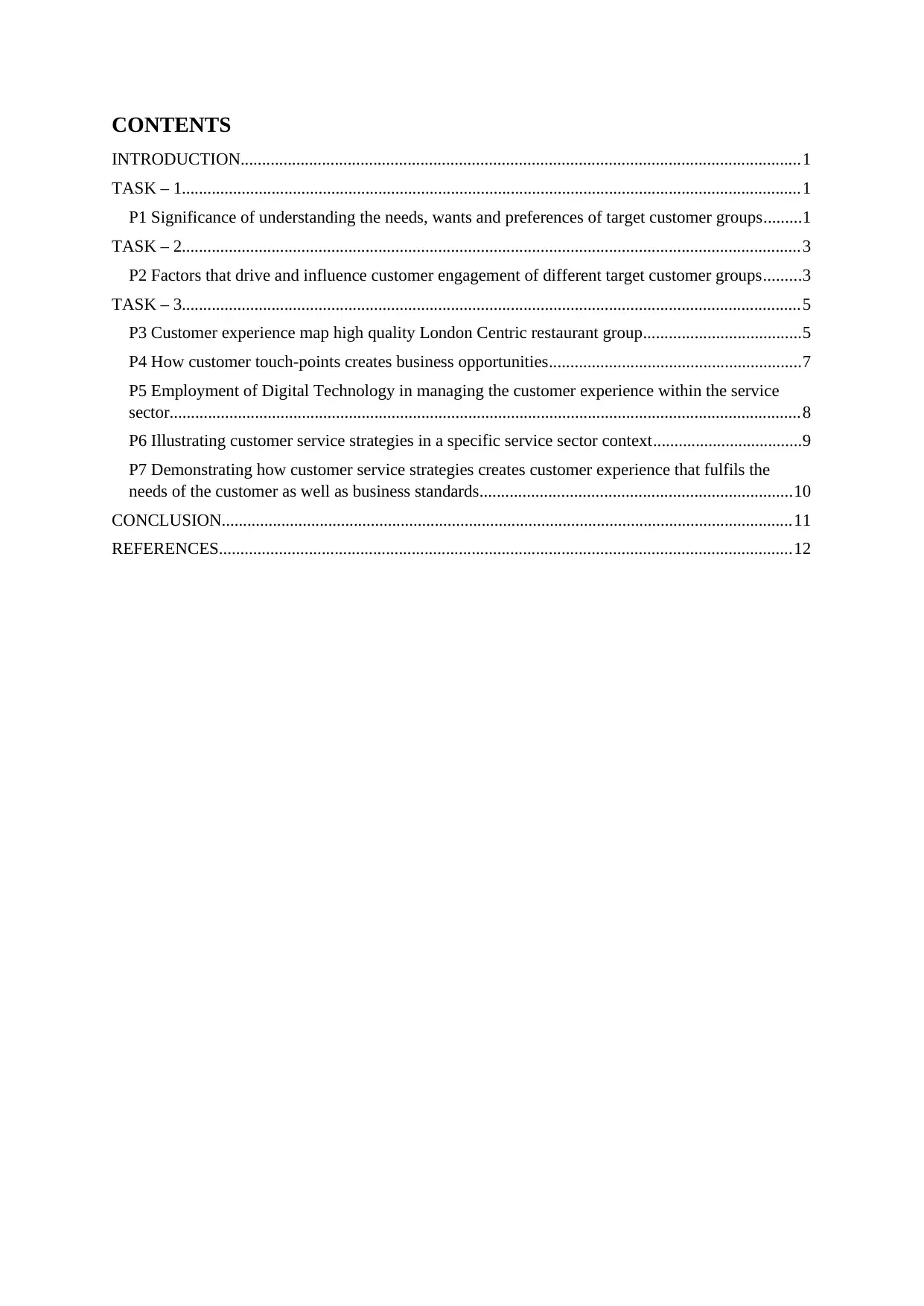
CONTENTS
INTRODUCTION...................................................................................................................................1
TASK – 1.................................................................................................................................................1
P1 Significance of understanding the needs, wants and preferences of target customer groups.........1
TASK – 2.................................................................................................................................................3
P2 Factors that drive and influence customer engagement of different target customer groups.........3
TASK – 3.................................................................................................................................................5
P3 Customer experience map high quality London Centric restaurant group.....................................5
P4 How customer touch-points creates business opportunities...........................................................7
P5 Employment of Digital Technology in managing the customer experience within the service
sector....................................................................................................................................................8
P6 Illustrating customer service strategies in a specific service sector context...................................9
P7 Demonstrating how customer service strategies creates customer experience that fulfils the
needs of the customer as well as business standards.........................................................................10
CONCLUSION......................................................................................................................................11
REFERENCES......................................................................................................................................12
INTRODUCTION...................................................................................................................................1
TASK – 1.................................................................................................................................................1
P1 Significance of understanding the needs, wants and preferences of target customer groups.........1
TASK – 2.................................................................................................................................................3
P2 Factors that drive and influence customer engagement of different target customer groups.........3
TASK – 3.................................................................................................................................................5
P3 Customer experience map high quality London Centric restaurant group.....................................5
P4 How customer touch-points creates business opportunities...........................................................7
P5 Employment of Digital Technology in managing the customer experience within the service
sector....................................................................................................................................................8
P6 Illustrating customer service strategies in a specific service sector context...................................9
P7 Demonstrating how customer service strategies creates customer experience that fulfils the
needs of the customer as well as business standards.........................................................................10
CONCLUSION......................................................................................................................................11
REFERENCES......................................................................................................................................12
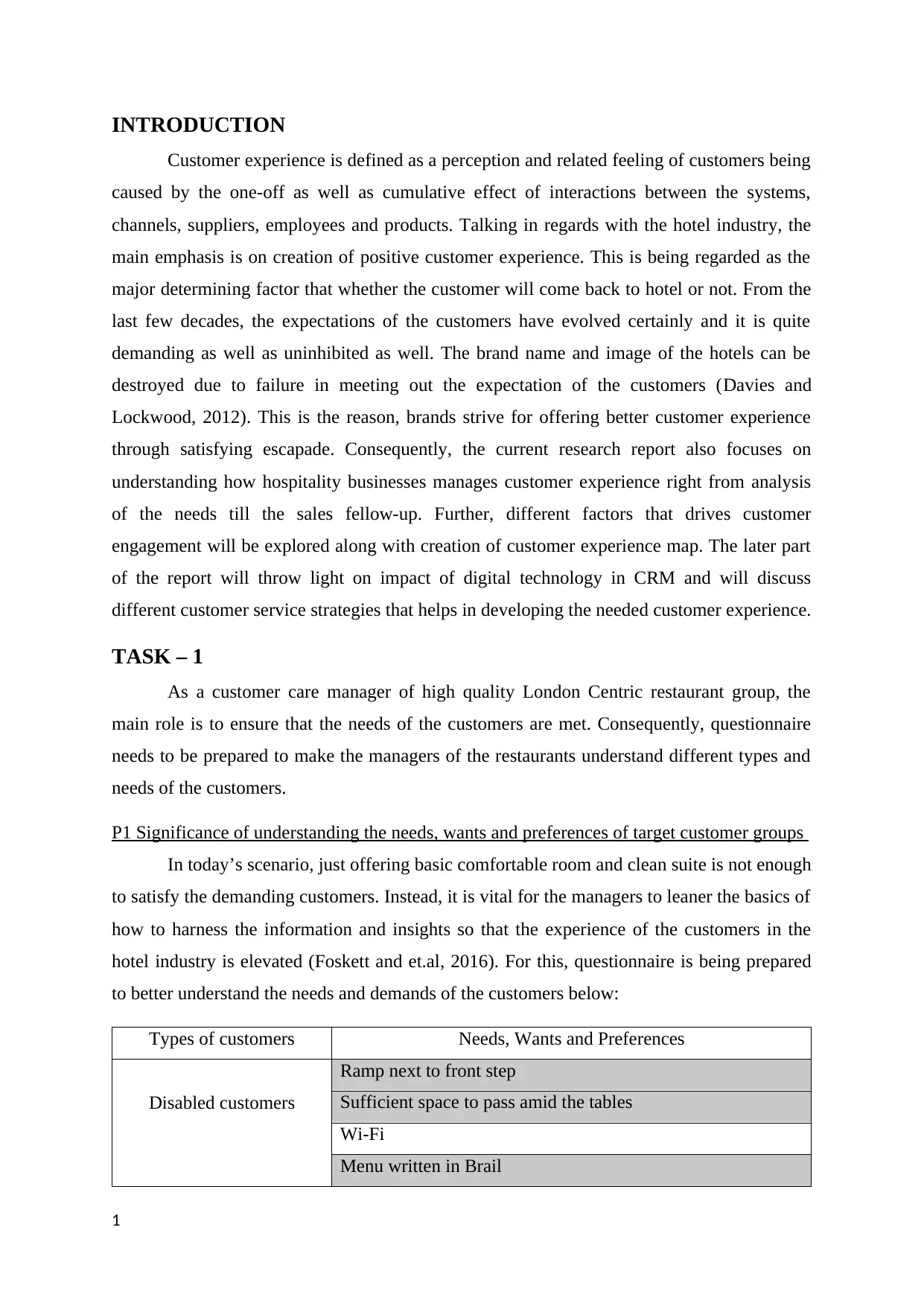
INTRODUCTION
Customer experience is defined as a perception and related feeling of customers being
caused by the one-off as well as cumulative effect of interactions between the systems,
channels, suppliers, employees and products. Talking in regards with the hotel industry, the
main emphasis is on creation of positive customer experience. This is being regarded as the
major determining factor that whether the customer will come back to hotel or not. From the
last few decades, the expectations of the customers have evolved certainly and it is quite
demanding as well as uninhibited as well. The brand name and image of the hotels can be
destroyed due to failure in meeting out the expectation of the customers (Davies and
Lockwood, 2012). This is the reason, brands strive for offering better customer experience
through satisfying escapade. Consequently, the current research report also focuses on
understanding how hospitality businesses manages customer experience right from analysis
of the needs till the sales fellow-up. Further, different factors that drives customer
engagement will be explored along with creation of customer experience map. The later part
of the report will throw light on impact of digital technology in CRM and will discuss
different customer service strategies that helps in developing the needed customer experience.
TASK – 1
As a customer care manager of high quality London Centric restaurant group, the
main role is to ensure that the needs of the customers are met. Consequently, questionnaire
needs to be prepared to make the managers of the restaurants understand different types and
needs of the customers.
P1 Significance of understanding the needs, wants and preferences of target customer groups
In today’s scenario, just offering basic comfortable room and clean suite is not enough
to satisfy the demanding customers. Instead, it is vital for the managers to leaner the basics of
how to harness the information and insights so that the experience of the customers in the
hotel industry is elevated (Foskett and et.al, 2016). For this, questionnaire is being prepared
to better understand the needs and demands of the customers below:
Types of customers Needs, Wants and Preferences
Disabled customers
Ramp next to front step
Sufficient space to pass amid the tables
Wi-Fi
Menu written in Brail
1
Customer experience is defined as a perception and related feeling of customers being
caused by the one-off as well as cumulative effect of interactions between the systems,
channels, suppliers, employees and products. Talking in regards with the hotel industry, the
main emphasis is on creation of positive customer experience. This is being regarded as the
major determining factor that whether the customer will come back to hotel or not. From the
last few decades, the expectations of the customers have evolved certainly and it is quite
demanding as well as uninhibited as well. The brand name and image of the hotels can be
destroyed due to failure in meeting out the expectation of the customers (Davies and
Lockwood, 2012). This is the reason, brands strive for offering better customer experience
through satisfying escapade. Consequently, the current research report also focuses on
understanding how hospitality businesses manages customer experience right from analysis
of the needs till the sales fellow-up. Further, different factors that drives customer
engagement will be explored along with creation of customer experience map. The later part
of the report will throw light on impact of digital technology in CRM and will discuss
different customer service strategies that helps in developing the needed customer experience.
TASK – 1
As a customer care manager of high quality London Centric restaurant group, the
main role is to ensure that the needs of the customers are met. Consequently, questionnaire
needs to be prepared to make the managers of the restaurants understand different types and
needs of the customers.
P1 Significance of understanding the needs, wants and preferences of target customer groups
In today’s scenario, just offering basic comfortable room and clean suite is not enough
to satisfy the demanding customers. Instead, it is vital for the managers to leaner the basics of
how to harness the information and insights so that the experience of the customers in the
hotel industry is elevated (Foskett and et.al, 2016). For this, questionnaire is being prepared
to better understand the needs and demands of the customers below:
Types of customers Needs, Wants and Preferences
Disabled customers
Ramp next to front step
Sufficient space to pass amid the tables
Wi-Fi
Menu written in Brail
1
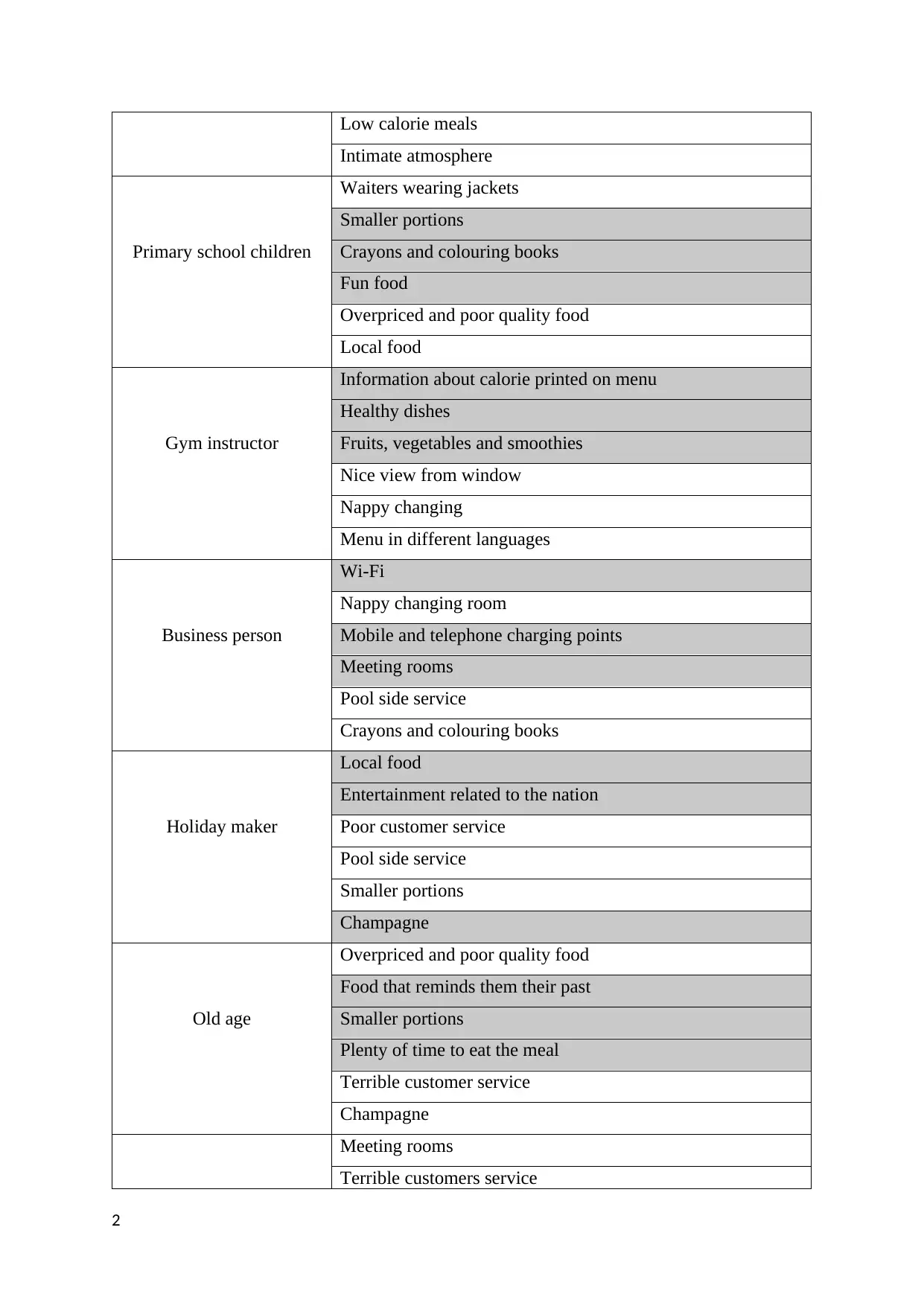
Low calorie meals
Intimate atmosphere
Primary school children
Waiters wearing jackets
Smaller portions
Crayons and colouring books
Fun food
Overpriced and poor quality food
Local food
Gym instructor
Information about calorie printed on menu
Healthy dishes
Fruits, vegetables and smoothies
Nice view from window
Nappy changing
Menu in different languages
Business person
Wi-Fi
Nappy changing room
Mobile and telephone charging points
Meeting rooms
Pool side service
Crayons and colouring books
Holiday maker
Local food
Entertainment related to the nation
Poor customer service
Pool side service
Smaller portions
Champagne
Old age
Overpriced and poor quality food
Food that reminds them their past
Smaller portions
Plenty of time to eat the meal
Terrible customer service
Champagne
Meeting rooms
Terrible customers service
2
Intimate atmosphere
Primary school children
Waiters wearing jackets
Smaller portions
Crayons and colouring books
Fun food
Overpriced and poor quality food
Local food
Gym instructor
Information about calorie printed on menu
Healthy dishes
Fruits, vegetables and smoothies
Nice view from window
Nappy changing
Menu in different languages
Business person
Wi-Fi
Nappy changing room
Mobile and telephone charging points
Meeting rooms
Pool side service
Crayons and colouring books
Holiday maker
Local food
Entertainment related to the nation
Poor customer service
Pool side service
Smaller portions
Champagne
Old age
Overpriced and poor quality food
Food that reminds them their past
Smaller portions
Plenty of time to eat the meal
Terrible customer service
Champagne
Meeting rooms
Terrible customers service
2
Secure Best Marks with AI Grader
Need help grading? Try our AI Grader for instant feedback on your assignments.
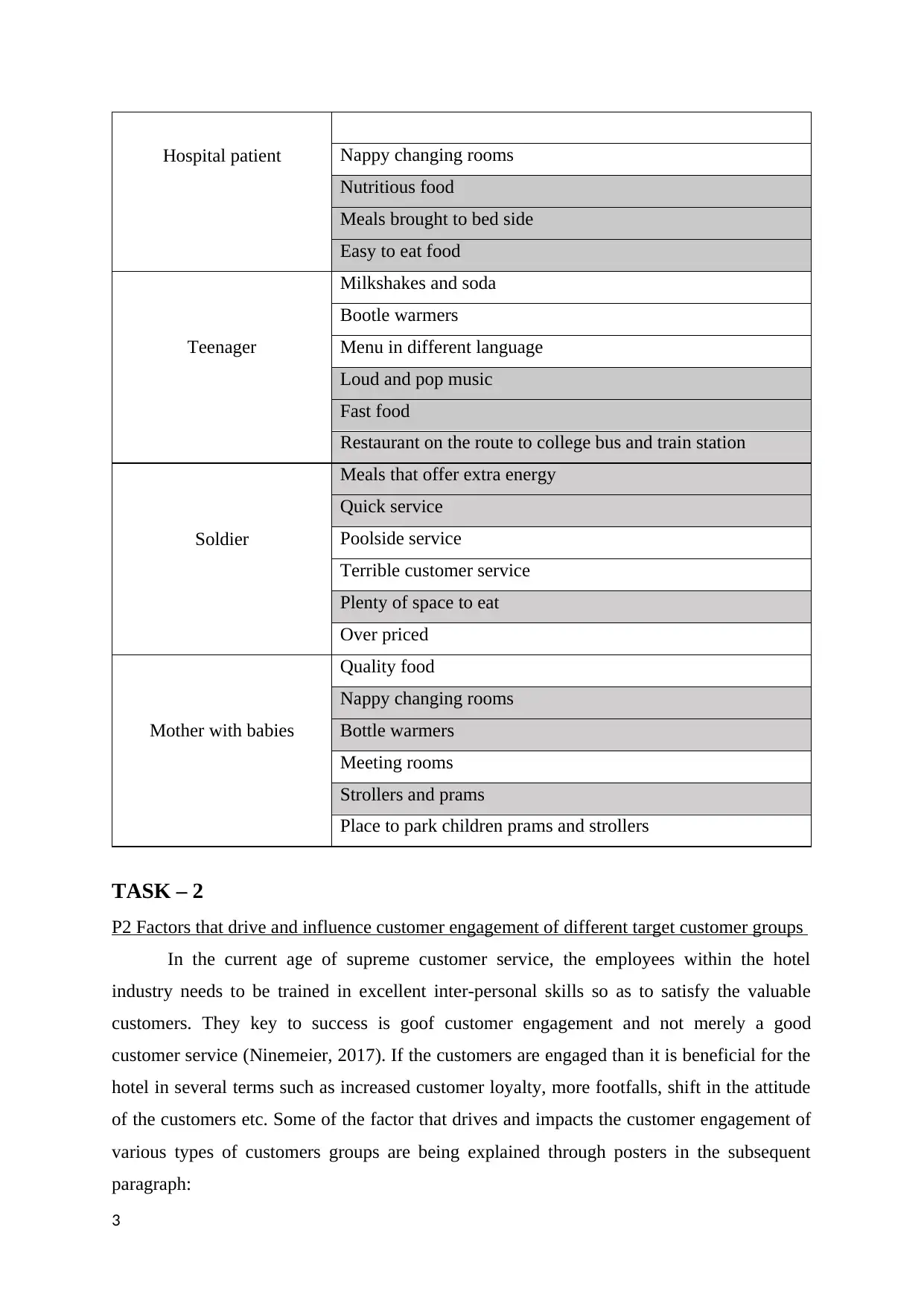
Hospital patient Nappy changing rooms
Nutritious food
Meals brought to bed side
Easy to eat food
Teenager
Milkshakes and soda
Bootle warmers
Menu in different language
Loud and pop music
Fast food
Restaurant on the route to college bus and train station
Soldier
Meals that offer extra energy
Quick service
Poolside service
Terrible customer service
Plenty of space to eat
Over priced
Mother with babies
Quality food
Nappy changing rooms
Bottle warmers
Meeting rooms
Strollers and prams
Place to park children prams and strollers
TASK – 2
P2 Factors that drive and influence customer engagement of different target customer groups
In the current age of supreme customer service, the employees within the hotel
industry needs to be trained in excellent inter-personal skills so as to satisfy the valuable
customers. They key to success is goof customer engagement and not merely a good
customer service (Ninemeier, 2017). If the customers are engaged than it is beneficial for the
hotel in several terms such as increased customer loyalty, more footfalls, shift in the attitude
of the customers etc. Some of the factor that drives and impacts the customer engagement of
various types of customers groups are being explained through posters in the subsequent
paragraph:
3
Nutritious food
Meals brought to bed side
Easy to eat food
Teenager
Milkshakes and soda
Bootle warmers
Menu in different language
Loud and pop music
Fast food
Restaurant on the route to college bus and train station
Soldier
Meals that offer extra energy
Quick service
Poolside service
Terrible customer service
Plenty of space to eat
Over priced
Mother with babies
Quality food
Nappy changing rooms
Bottle warmers
Meeting rooms
Strollers and prams
Place to park children prams and strollers
TASK – 2
P2 Factors that drive and influence customer engagement of different target customer groups
In the current age of supreme customer service, the employees within the hotel
industry needs to be trained in excellent inter-personal skills so as to satisfy the valuable
customers. They key to success is goof customer engagement and not merely a good
customer service (Ninemeier, 2017). If the customers are engaged than it is beneficial for the
hotel in several terms such as increased customer loyalty, more footfalls, shift in the attitude
of the customers etc. Some of the factor that drives and impacts the customer engagement of
various types of customers groups are being explained through posters in the subsequent
paragraph:
3
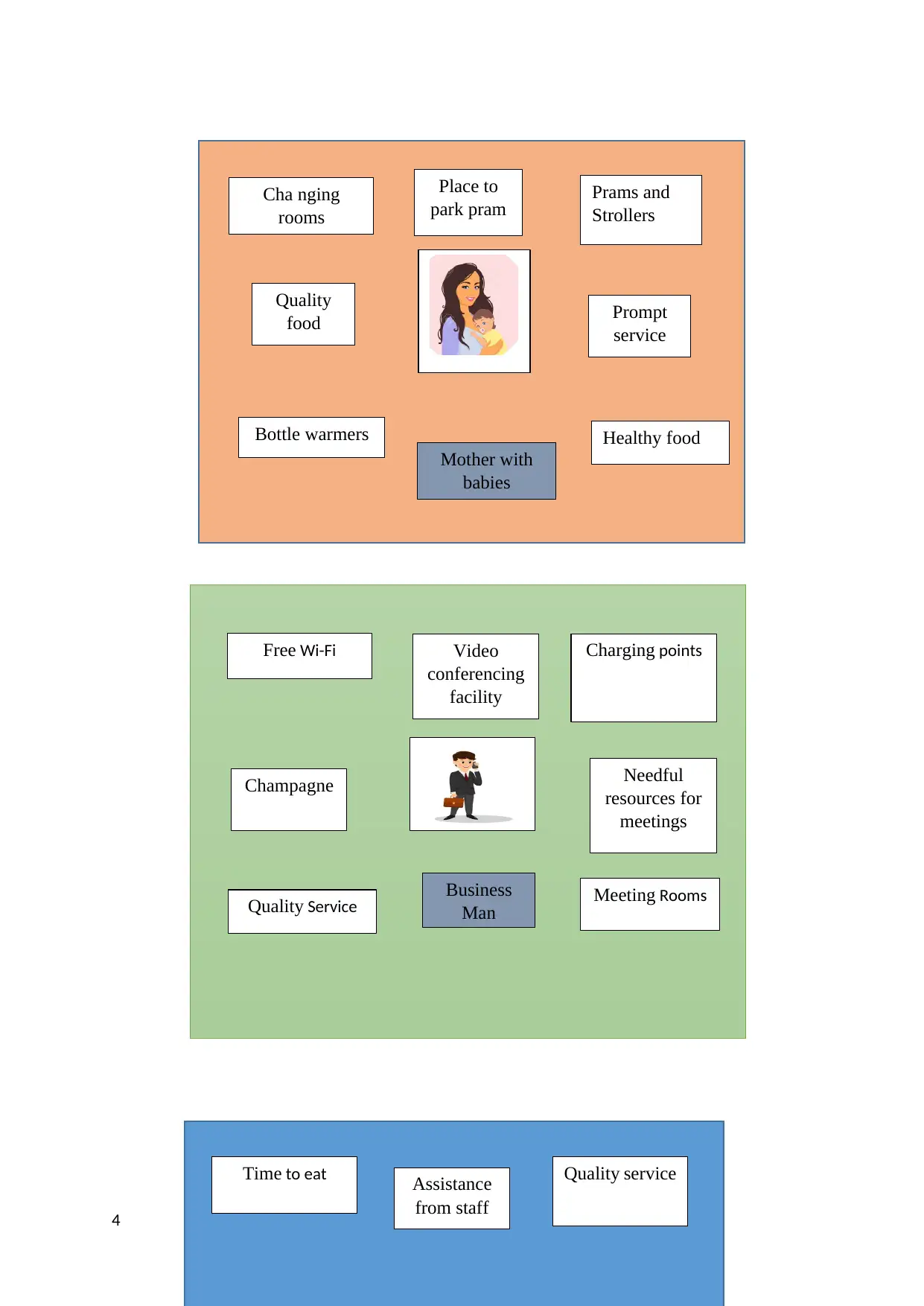
4
Cha nging
rooms
Bottle warmers
Prams and
Strollers
Healthy food
Free Wi-Fi
Quality Service
Charging points
Meeting Rooms
Time to eat Quality service
Mother with
babies
Business
Man
Place to
park pram
Prompt
service
Quality
food
Video
conferencing
facility
Champagne Needful
resources for
meetings
Assistance
from staff
Cha nging
rooms
Bottle warmers
Prams and
Strollers
Healthy food
Free Wi-Fi
Quality Service
Charging points
Meeting Rooms
Time to eat Quality service
Mother with
babies
Business
Man
Place to
park pram
Prompt
service
Quality
food
Video
conferencing
facility
Champagne Needful
resources for
meetings
Assistance
from staff
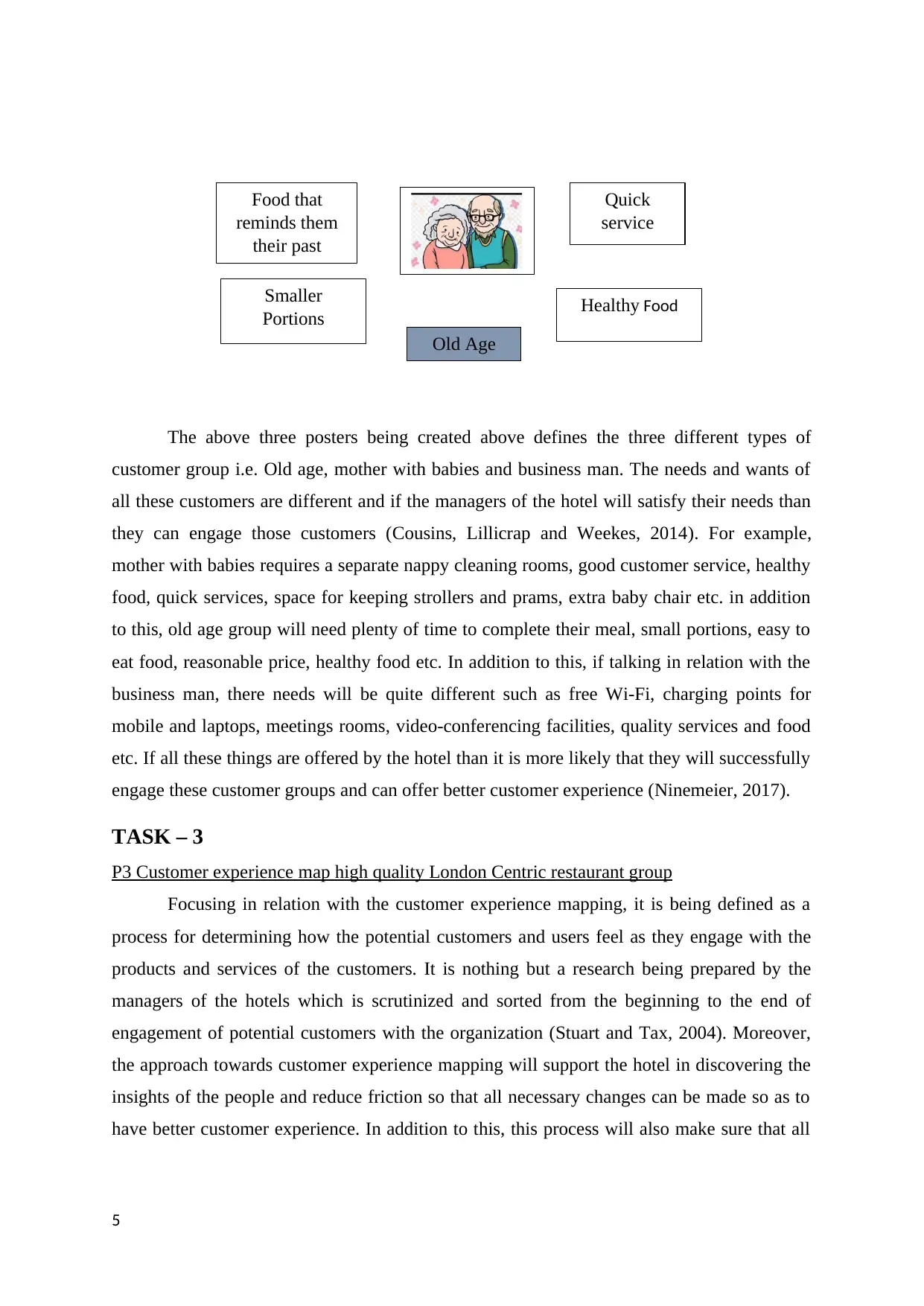
The above three posters being created above defines the three different types of
customer group i.e. Old age, mother with babies and business man. The needs and wants of
all these customers are different and if the managers of the hotel will satisfy their needs than
they can engage those customers (Cousins, Lillicrap and Weekes, 2014). For example,
mother with babies requires a separate nappy cleaning rooms, good customer service, healthy
food, quick services, space for keeping strollers and prams, extra baby chair etc. in addition
to this, old age group will need plenty of time to complete their meal, small portions, easy to
eat food, reasonable price, healthy food etc. In addition to this, if talking in relation with the
business man, there needs will be quite different such as free Wi-Fi, charging points for
mobile and laptops, meetings rooms, video-conferencing facilities, quality services and food
etc. If all these things are offered by the hotel than it is more likely that they will successfully
engage these customer groups and can offer better customer experience (Ninemeier, 2017).
TASK – 3
P3 Customer experience map high quality London Centric restaurant group
Focusing in relation with the customer experience mapping, it is being defined as a
process for determining how the potential customers and users feel as they engage with the
products and services of the customers. It is nothing but a research being prepared by the
managers of the hotels which is scrutinized and sorted from the beginning to the end of
engagement of potential customers with the organization (Stuart and Tax, 2004). Moreover,
the approach towards customer experience mapping will support the hotel in discovering the
insights of the people and reduce friction so that all necessary changes can be made so as to
have better customer experience. In addition to this, this process will also make sure that all
5
Smaller
Portions Healthy Food
Old Age
Food that
reminds them
their past
Quick
service
customer group i.e. Old age, mother with babies and business man. The needs and wants of
all these customers are different and if the managers of the hotel will satisfy their needs than
they can engage those customers (Cousins, Lillicrap and Weekes, 2014). For example,
mother with babies requires a separate nappy cleaning rooms, good customer service, healthy
food, quick services, space for keeping strollers and prams, extra baby chair etc. in addition
to this, old age group will need plenty of time to complete their meal, small portions, easy to
eat food, reasonable price, healthy food etc. In addition to this, if talking in relation with the
business man, there needs will be quite different such as free Wi-Fi, charging points for
mobile and laptops, meetings rooms, video-conferencing facilities, quality services and food
etc. If all these things are offered by the hotel than it is more likely that they will successfully
engage these customer groups and can offer better customer experience (Ninemeier, 2017).
TASK – 3
P3 Customer experience map high quality London Centric restaurant group
Focusing in relation with the customer experience mapping, it is being defined as a
process for determining how the potential customers and users feel as they engage with the
products and services of the customers. It is nothing but a research being prepared by the
managers of the hotels which is scrutinized and sorted from the beginning to the end of
engagement of potential customers with the organization (Stuart and Tax, 2004). Moreover,
the approach towards customer experience mapping will support the hotel in discovering the
insights of the people and reduce friction so that all necessary changes can be made so as to
have better customer experience. In addition to this, this process will also make sure that all
5
Smaller
Portions Healthy Food
Old Age
Food that
reminds them
their past
Quick
service
Paraphrase This Document
Need a fresh take? Get an instant paraphrase of this document with our AI Paraphraser
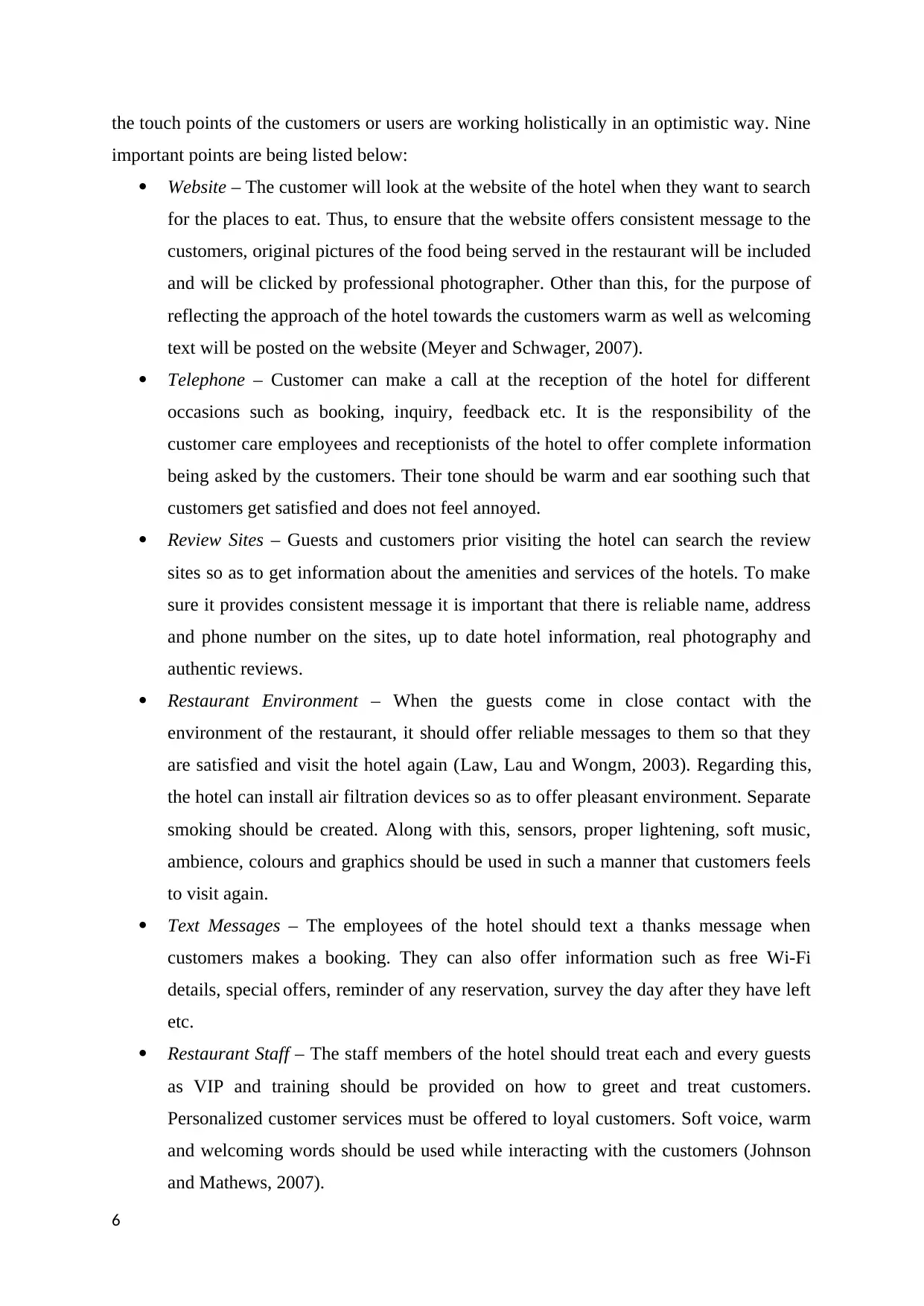
the touch points of the customers or users are working holistically in an optimistic way. Nine
important points are being listed below:
Website – The customer will look at the website of the hotel when they want to search
for the places to eat. Thus, to ensure that the website offers consistent message to the
customers, original pictures of the food being served in the restaurant will be included
and will be clicked by professional photographer. Other than this, for the purpose of
reflecting the approach of the hotel towards the customers warm as well as welcoming
text will be posted on the website (Meyer and Schwager, 2007).
Telephone – Customer can make a call at the reception of the hotel for different
occasions such as booking, inquiry, feedback etc. It is the responsibility of the
customer care employees and receptionists of the hotel to offer complete information
being asked by the customers. Their tone should be warm and ear soothing such that
customers get satisfied and does not feel annoyed.
Review Sites – Guests and customers prior visiting the hotel can search the review
sites so as to get information about the amenities and services of the hotels. To make
sure it provides consistent message it is important that there is reliable name, address
and phone number on the sites, up to date hotel information, real photography and
authentic reviews.
Restaurant Environment – When the guests come in close contact with the
environment of the restaurant, it should offer reliable messages to them so that they
are satisfied and visit the hotel again (Law, Lau and Wongm, 2003). Regarding this,
the hotel can install air filtration devices so as to offer pleasant environment. Separate
smoking should be created. Along with this, sensors, proper lightening, soft music,
ambience, colours and graphics should be used in such a manner that customers feels
to visit again.
Text Messages – The employees of the hotel should text a thanks message when
customers makes a booking. They can also offer information such as free Wi-Fi
details, special offers, reminder of any reservation, survey the day after they have left
etc.
Restaurant Staff – The staff members of the hotel should treat each and every guests
as VIP and training should be provided on how to greet and treat customers.
Personalized customer services must be offered to loyal customers. Soft voice, warm
and welcoming words should be used while interacting with the customers (Johnson
and Mathews, 2007).
6
important points are being listed below:
Website – The customer will look at the website of the hotel when they want to search
for the places to eat. Thus, to ensure that the website offers consistent message to the
customers, original pictures of the food being served in the restaurant will be included
and will be clicked by professional photographer. Other than this, for the purpose of
reflecting the approach of the hotel towards the customers warm as well as welcoming
text will be posted on the website (Meyer and Schwager, 2007).
Telephone – Customer can make a call at the reception of the hotel for different
occasions such as booking, inquiry, feedback etc. It is the responsibility of the
customer care employees and receptionists of the hotel to offer complete information
being asked by the customers. Their tone should be warm and ear soothing such that
customers get satisfied and does not feel annoyed.
Review Sites – Guests and customers prior visiting the hotel can search the review
sites so as to get information about the amenities and services of the hotels. To make
sure it provides consistent message it is important that there is reliable name, address
and phone number on the sites, up to date hotel information, real photography and
authentic reviews.
Restaurant Environment – When the guests come in close contact with the
environment of the restaurant, it should offer reliable messages to them so that they
are satisfied and visit the hotel again (Law, Lau and Wongm, 2003). Regarding this,
the hotel can install air filtration devices so as to offer pleasant environment. Separate
smoking should be created. Along with this, sensors, proper lightening, soft music,
ambience, colours and graphics should be used in such a manner that customers feels
to visit again.
Text Messages – The employees of the hotel should text a thanks message when
customers makes a booking. They can also offer information such as free Wi-Fi
details, special offers, reminder of any reservation, survey the day after they have left
etc.
Restaurant Staff – The staff members of the hotel should treat each and every guests
as VIP and training should be provided on how to greet and treat customers.
Personalized customer services must be offered to loyal customers. Soft voice, warm
and welcoming words should be used while interacting with the customers (Johnson
and Mathews, 2007).
6
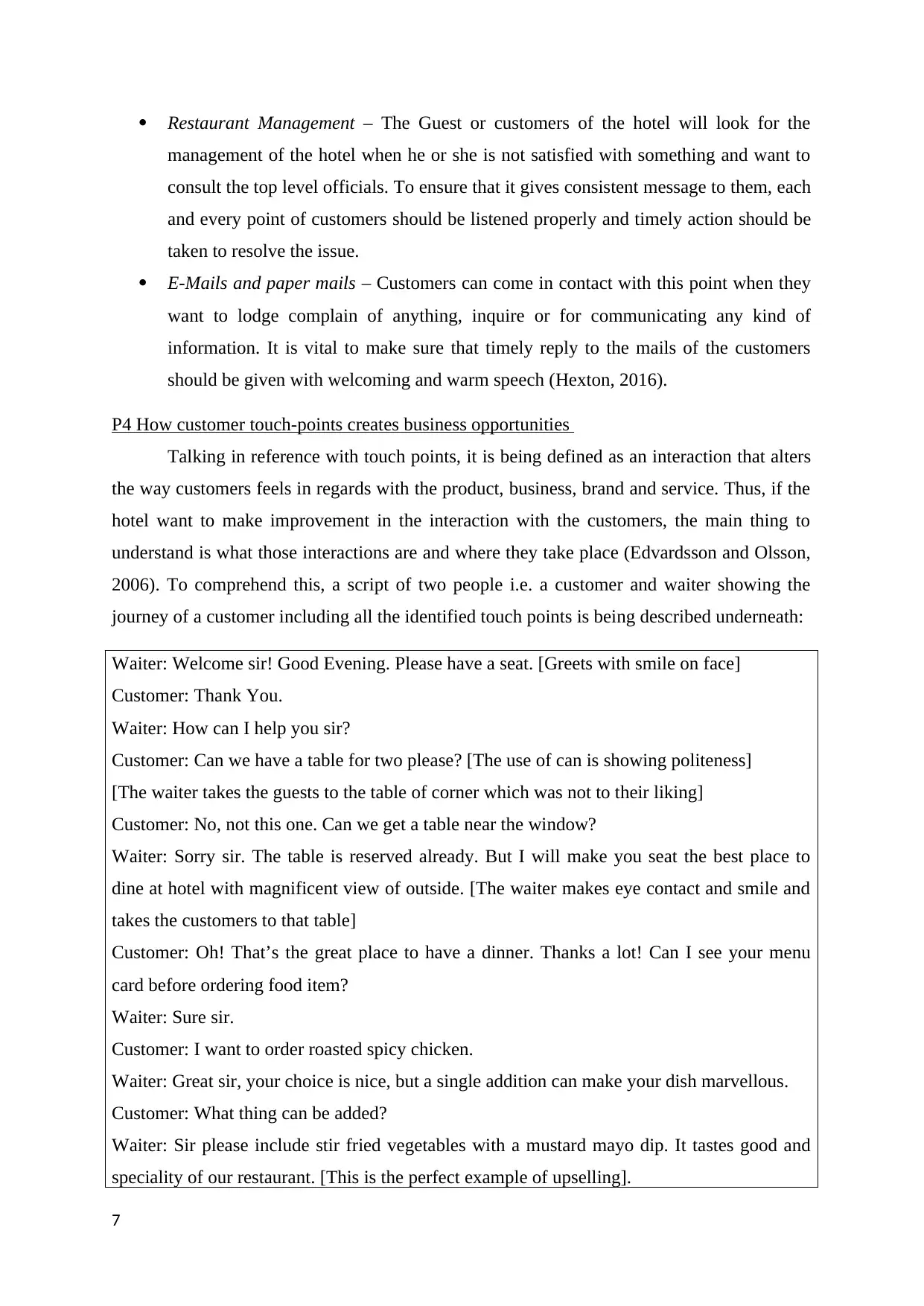
Restaurant Management – The Guest or customers of the hotel will look for the
management of the hotel when he or she is not satisfied with something and want to
consult the top level officials. To ensure that it gives consistent message to them, each
and every point of customers should be listened properly and timely action should be
taken to resolve the issue.
E-Mails and paper mails – Customers can come in contact with this point when they
want to lodge complain of anything, inquire or for communicating any kind of
information. It is vital to make sure that timely reply to the mails of the customers
should be given with welcoming and warm speech (Hexton, 2016).
P4 How customer touch-points creates business opportunities
Talking in reference with touch points, it is being defined as an interaction that alters
the way customers feels in regards with the product, business, brand and service. Thus, if the
hotel want to make improvement in the interaction with the customers, the main thing to
understand is what those interactions are and where they take place (Edvardsson and Olsson,
2006). To comprehend this, a script of two people i.e. a customer and waiter showing the
journey of a customer including all the identified touch points is being described underneath:
Waiter: Welcome sir! Good Evening. Please have a seat. [Greets with smile on face]
Customer: Thank You.
Waiter: How can I help you sir?
Customer: Can we have a table for two please? [The use of can is showing politeness]
[The waiter takes the guests to the table of corner which was not to their liking]
Customer: No, not this one. Can we get a table near the window?
Waiter: Sorry sir. The table is reserved already. But I will make you seat the best place to
dine at hotel with magnificent view of outside. [The waiter makes eye contact and smile and
takes the customers to that table]
Customer: Oh! That’s the great place to have a dinner. Thanks a lot! Can I see your menu
card before ordering food item?
Waiter: Sure sir.
Customer: I want to order roasted spicy chicken.
Waiter: Great sir, your choice is nice, but a single addition can make your dish marvellous.
Customer: What thing can be added?
Waiter: Sir please include stir fried vegetables with a mustard mayo dip. It tastes good and
speciality of our restaurant. [This is the perfect example of upselling].
7
management of the hotel when he or she is not satisfied with something and want to
consult the top level officials. To ensure that it gives consistent message to them, each
and every point of customers should be listened properly and timely action should be
taken to resolve the issue.
E-Mails and paper mails – Customers can come in contact with this point when they
want to lodge complain of anything, inquire or for communicating any kind of
information. It is vital to make sure that timely reply to the mails of the customers
should be given with welcoming and warm speech (Hexton, 2016).
P4 How customer touch-points creates business opportunities
Talking in reference with touch points, it is being defined as an interaction that alters
the way customers feels in regards with the product, business, brand and service. Thus, if the
hotel want to make improvement in the interaction with the customers, the main thing to
understand is what those interactions are and where they take place (Edvardsson and Olsson,
2006). To comprehend this, a script of two people i.e. a customer and waiter showing the
journey of a customer including all the identified touch points is being described underneath:
Waiter: Welcome sir! Good Evening. Please have a seat. [Greets with smile on face]
Customer: Thank You.
Waiter: How can I help you sir?
Customer: Can we have a table for two please? [The use of can is showing politeness]
[The waiter takes the guests to the table of corner which was not to their liking]
Customer: No, not this one. Can we get a table near the window?
Waiter: Sorry sir. The table is reserved already. But I will make you seat the best place to
dine at hotel with magnificent view of outside. [The waiter makes eye contact and smile and
takes the customers to that table]
Customer: Oh! That’s the great place to have a dinner. Thanks a lot! Can I see your menu
card before ordering food item?
Waiter: Sure sir.
Customer: I want to order roasted spicy chicken.
Waiter: Great sir, your choice is nice, but a single addition can make your dish marvellous.
Customer: What thing can be added?
Waiter: Sir please include stir fried vegetables with a mustard mayo dip. It tastes good and
speciality of our restaurant. [This is the perfect example of upselling].
7
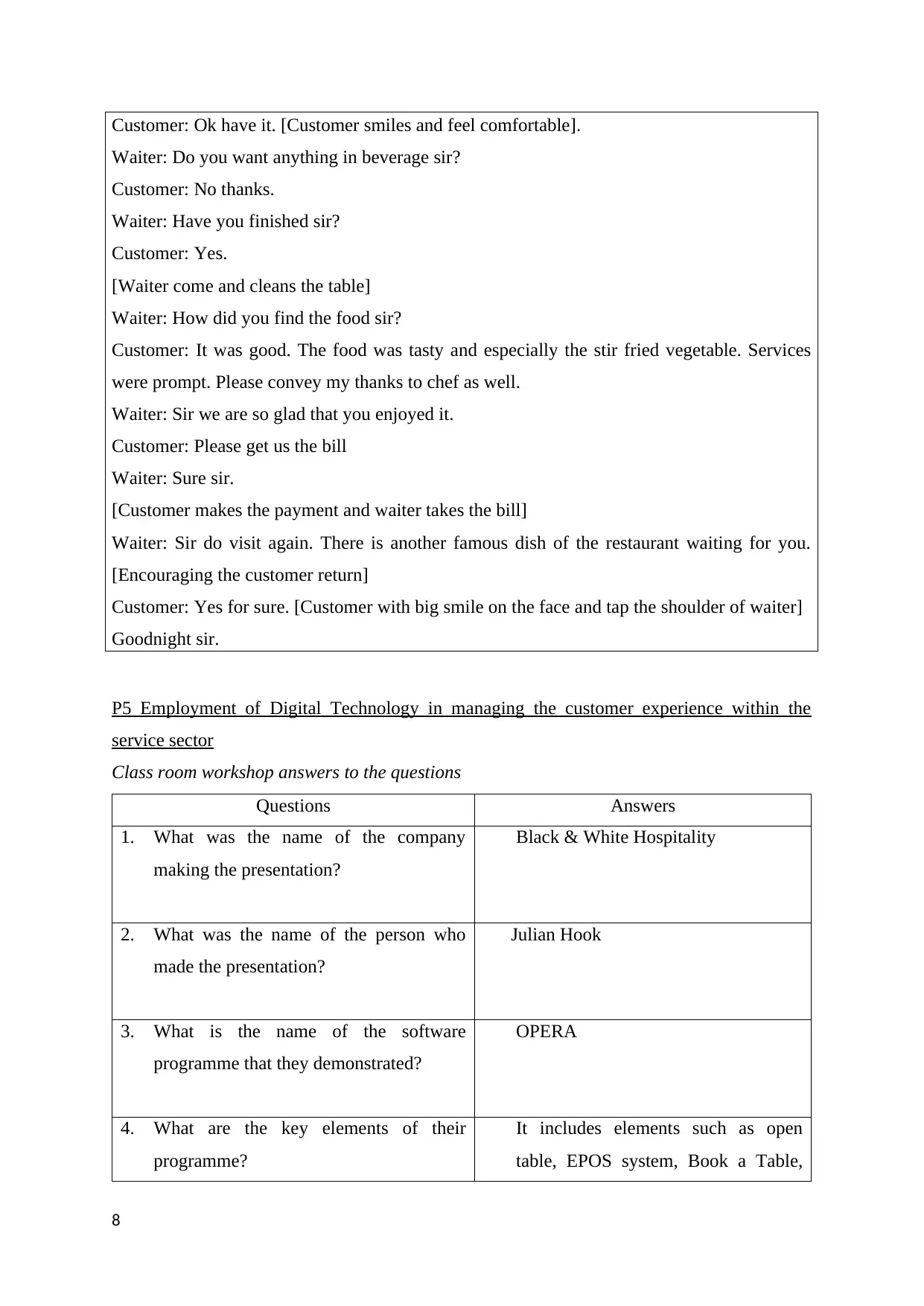
Customer: Ok have it. [Customer smiles and feel comfortable].
Waiter: Do you want anything in beverage sir?
Customer: No thanks.
Waiter: Have you finished sir?
Customer: Yes.
[Waiter come and cleans the table]
Waiter: How did you find the food sir?
Customer: It was good. The food was tasty and especially the stir fried vegetable. Services
were prompt. Please convey my thanks to chef as well.
Waiter: Sir we are so glad that you enjoyed it.
Customer: Please get us the bill
Waiter: Sure sir.
[Customer makes the payment and waiter takes the bill]
Waiter: Sir do visit again. There is another famous dish of the restaurant waiting for you.
[Encouraging the customer return]
Customer: Yes for sure. [Customer with big smile on the face and tap the shoulder of waiter]
Goodnight sir.
P5 Employment of Digital Technology in managing the customer experience within the
service sector
Class room workshop answers to the questions
Questions Answers
1. What was the name of the company
making the presentation?
Black & White Hospitality
2. What was the name of the person who
made the presentation?
Julian Hook
3. What is the name of the software
programme that they demonstrated?
OPERA
4. What are the key elements of their
programme?
It includes elements such as open
table, EPOS system, Book a Table,
8
Waiter: Do you want anything in beverage sir?
Customer: No thanks.
Waiter: Have you finished sir?
Customer: Yes.
[Waiter come and cleans the table]
Waiter: How did you find the food sir?
Customer: It was good. The food was tasty and especially the stir fried vegetable. Services
were prompt. Please convey my thanks to chef as well.
Waiter: Sir we are so glad that you enjoyed it.
Customer: Please get us the bill
Waiter: Sure sir.
[Customer makes the payment and waiter takes the bill]
Waiter: Sir do visit again. There is another famous dish of the restaurant waiting for you.
[Encouraging the customer return]
Customer: Yes for sure. [Customer with big smile on the face and tap the shoulder of waiter]
Goodnight sir.
P5 Employment of Digital Technology in managing the customer experience within the
service sector
Class room workshop answers to the questions
Questions Answers
1. What was the name of the company
making the presentation?
Black & White Hospitality
2. What was the name of the person who
made the presentation?
Julian Hook
3. What is the name of the software
programme that they demonstrated?
OPERA
4. What are the key elements of their
programme?
It includes elements such as open
table, EPOS system, Book a Table,
8
Secure Best Marks with AI Grader
Need help grading? Try our AI Grader for instant feedback on your assignments.
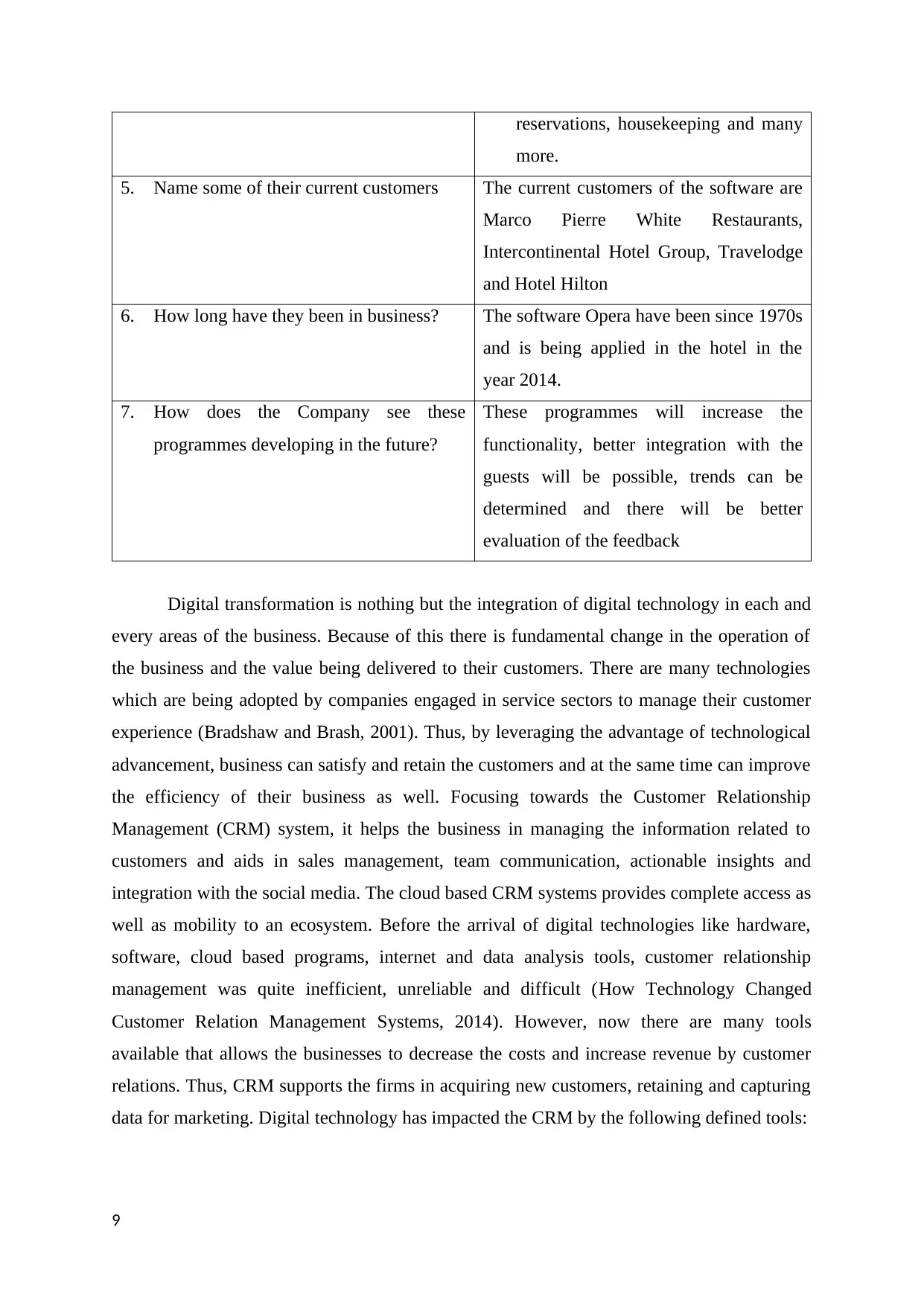
reservations, housekeeping and many
more.
5. Name some of their current customers The current customers of the software are
Marco Pierre White Restaurants,
Intercontinental Hotel Group, Travelodge
and Hotel Hilton
6. How long have they been in business? The software Opera have been since 1970s
and is being applied in the hotel in the
year 2014.
7. How does the Company see these
programmes developing in the future?
These programmes will increase the
functionality, better integration with the
guests will be possible, trends can be
determined and there will be better
evaluation of the feedback
Digital transformation is nothing but the integration of digital technology in each and
every areas of the business. Because of this there is fundamental change in the operation of
the business and the value being delivered to their customers. There are many technologies
which are being adopted by companies engaged in service sectors to manage their customer
experience (Bradshaw and Brash, 2001). Thus, by leveraging the advantage of technological
advancement, business can satisfy and retain the customers and at the same time can improve
the efficiency of their business as well. Focusing towards the Customer Relationship
Management (CRM) system, it helps the business in managing the information related to
customers and aids in sales management, team communication, actionable insights and
integration with the social media. The cloud based CRM systems provides complete access as
well as mobility to an ecosystem. Before the arrival of digital technologies like hardware,
software, cloud based programs, internet and data analysis tools, customer relationship
management was quite inefficient, unreliable and difficult (How Technology Changed
Customer Relation Management Systems, 2014). However, now there are many tools
available that allows the businesses to decrease the costs and increase revenue by customer
relations. Thus, CRM supports the firms in acquiring new customers, retaining and capturing
data for marketing. Digital technology has impacted the CRM by the following defined tools:
9
more.
5. Name some of their current customers The current customers of the software are
Marco Pierre White Restaurants,
Intercontinental Hotel Group, Travelodge
and Hotel Hilton
6. How long have they been in business? The software Opera have been since 1970s
and is being applied in the hotel in the
year 2014.
7. How does the Company see these
programmes developing in the future?
These programmes will increase the
functionality, better integration with the
guests will be possible, trends can be
determined and there will be better
evaluation of the feedback
Digital transformation is nothing but the integration of digital technology in each and
every areas of the business. Because of this there is fundamental change in the operation of
the business and the value being delivered to their customers. There are many technologies
which are being adopted by companies engaged in service sectors to manage their customer
experience (Bradshaw and Brash, 2001). Thus, by leveraging the advantage of technological
advancement, business can satisfy and retain the customers and at the same time can improve
the efficiency of their business as well. Focusing towards the Customer Relationship
Management (CRM) system, it helps the business in managing the information related to
customers and aids in sales management, team communication, actionable insights and
integration with the social media. The cloud based CRM systems provides complete access as
well as mobility to an ecosystem. Before the arrival of digital technologies like hardware,
software, cloud based programs, internet and data analysis tools, customer relationship
management was quite inefficient, unreliable and difficult (How Technology Changed
Customer Relation Management Systems, 2014). However, now there are many tools
available that allows the businesses to decrease the costs and increase revenue by customer
relations. Thus, CRM supports the firms in acquiring new customers, retaining and capturing
data for marketing. Digital technology has impacted the CRM by the following defined tools:
9
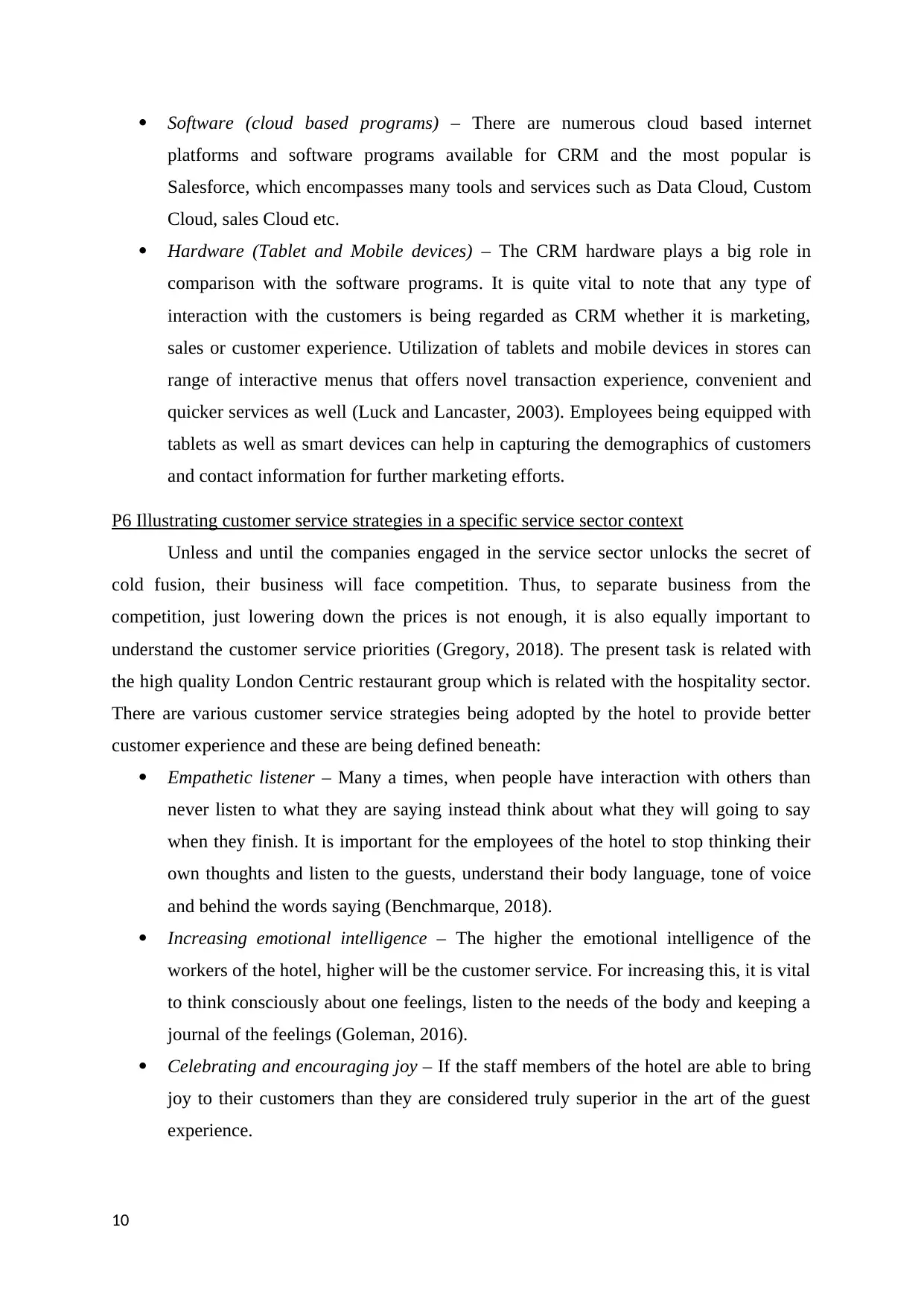
Software (cloud based programs) – There are numerous cloud based internet
platforms and software programs available for CRM and the most popular is
Salesforce, which encompasses many tools and services such as Data Cloud, Custom
Cloud, sales Cloud etc.
Hardware (Tablet and Mobile devices) – The CRM hardware plays a big role in
comparison with the software programs. It is quite vital to note that any type of
interaction with the customers is being regarded as CRM whether it is marketing,
sales or customer experience. Utilization of tablets and mobile devices in stores can
range of interactive menus that offers novel transaction experience, convenient and
quicker services as well (Luck and Lancaster, 2003). Employees being equipped with
tablets as well as smart devices can help in capturing the demographics of customers
and contact information for further marketing efforts.
P6 Illustrating customer service strategies in a specific service sector context
Unless and until the companies engaged in the service sector unlocks the secret of
cold fusion, their business will face competition. Thus, to separate business from the
competition, just lowering down the prices is not enough, it is also equally important to
understand the customer service priorities (Gregory, 2018). The present task is related with
the high quality London Centric restaurant group which is related with the hospitality sector.
There are various customer service strategies being adopted by the hotel to provide better
customer experience and these are being defined beneath:
Empathetic listener – Many a times, when people have interaction with others than
never listen to what they are saying instead think about what they will going to say
when they finish. It is important for the employees of the hotel to stop thinking their
own thoughts and listen to the guests, understand their body language, tone of voice
and behind the words saying (Benchmarque, 2018).
Increasing emotional intelligence – The higher the emotional intelligence of the
workers of the hotel, higher will be the customer service. For increasing this, it is vital
to think consciously about one feelings, listen to the needs of the body and keeping a
journal of the feelings (Goleman, 2016).
Celebrating and encouraging joy – If the staff members of the hotel are able to bring
joy to their customers than they are considered truly superior in the art of the guest
experience.
10
platforms and software programs available for CRM and the most popular is
Salesforce, which encompasses many tools and services such as Data Cloud, Custom
Cloud, sales Cloud etc.
Hardware (Tablet and Mobile devices) – The CRM hardware plays a big role in
comparison with the software programs. It is quite vital to note that any type of
interaction with the customers is being regarded as CRM whether it is marketing,
sales or customer experience. Utilization of tablets and mobile devices in stores can
range of interactive menus that offers novel transaction experience, convenient and
quicker services as well (Luck and Lancaster, 2003). Employees being equipped with
tablets as well as smart devices can help in capturing the demographics of customers
and contact information for further marketing efforts.
P6 Illustrating customer service strategies in a specific service sector context
Unless and until the companies engaged in the service sector unlocks the secret of
cold fusion, their business will face competition. Thus, to separate business from the
competition, just lowering down the prices is not enough, it is also equally important to
understand the customer service priorities (Gregory, 2018). The present task is related with
the high quality London Centric restaurant group which is related with the hospitality sector.
There are various customer service strategies being adopted by the hotel to provide better
customer experience and these are being defined beneath:
Empathetic listener – Many a times, when people have interaction with others than
never listen to what they are saying instead think about what they will going to say
when they finish. It is important for the employees of the hotel to stop thinking their
own thoughts and listen to the guests, understand their body language, tone of voice
and behind the words saying (Benchmarque, 2018).
Increasing emotional intelligence – The higher the emotional intelligence of the
workers of the hotel, higher will be the customer service. For increasing this, it is vital
to think consciously about one feelings, listen to the needs of the body and keeping a
journal of the feelings (Goleman, 2016).
Celebrating and encouraging joy – If the staff members of the hotel are able to bring
joy to their customers than they are considered truly superior in the art of the guest
experience.
10
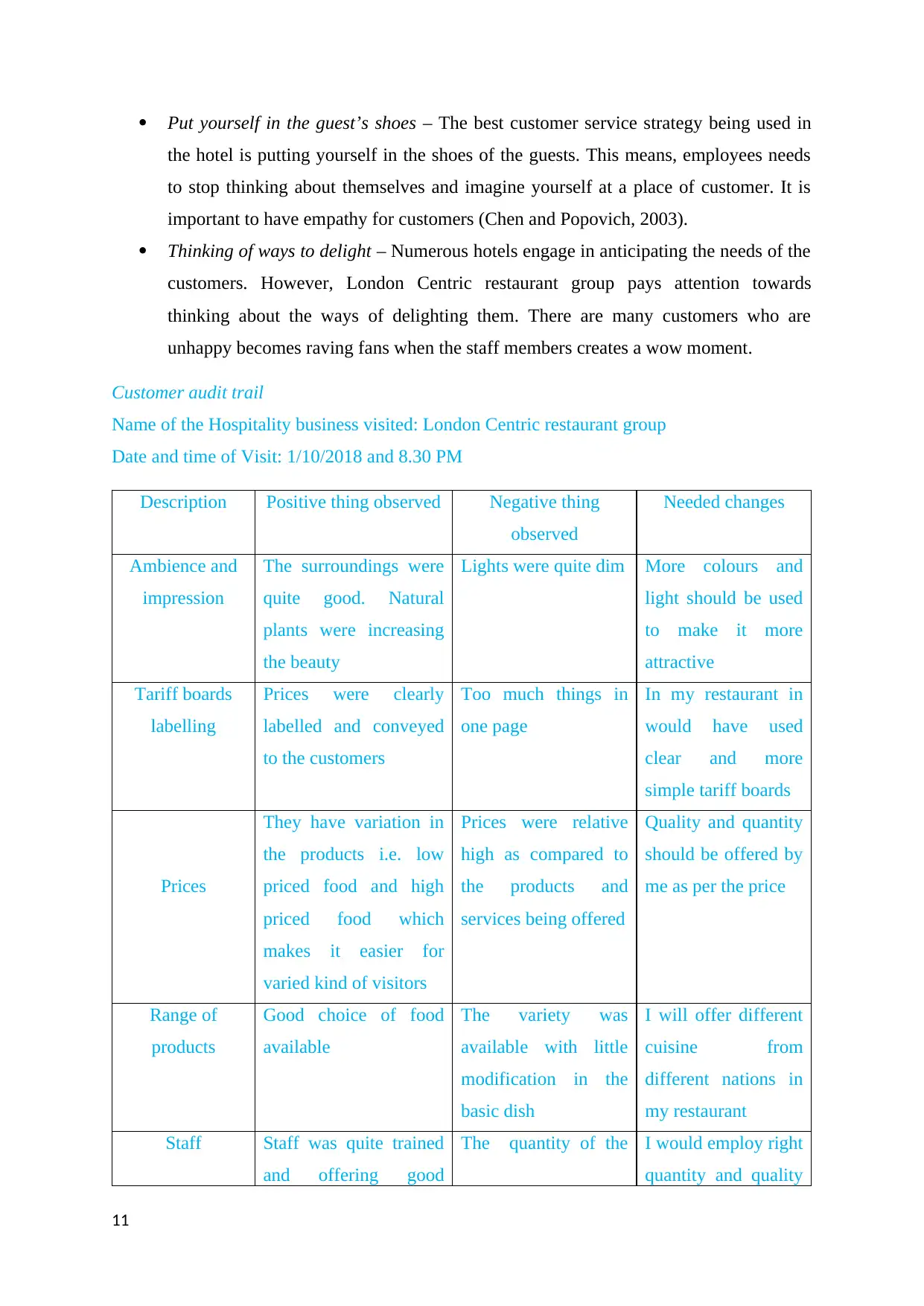
Put yourself in the guest’s shoes – The best customer service strategy being used in
the hotel is putting yourself in the shoes of the guests. This means, employees needs
to stop thinking about themselves and imagine yourself at a place of customer. It is
important to have empathy for customers (Chen and Popovich, 2003).
Thinking of ways to delight – Numerous hotels engage in anticipating the needs of the
customers. However, London Centric restaurant group pays attention towards
thinking about the ways of delighting them. There are many customers who are
unhappy becomes raving fans when the staff members creates a wow moment.
Customer audit trail
Name of the Hospitality business visited: London Centric restaurant group
Date and time of Visit: 1/10/2018 and 8.30 PM
Description Positive thing observed Negative thing
observed
Needed changes
Ambience and
impression
The surroundings were
quite good. Natural
plants were increasing
the beauty
Lights were quite dim More colours and
light should be used
to make it more
attractive
Tariff boards
labelling
Prices were clearly
labelled and conveyed
to the customers
Too much things in
one page
In my restaurant in
would have used
clear and more
simple tariff boards
Prices
They have variation in
the products i.e. low
priced food and high
priced food which
makes it easier for
varied kind of visitors
Prices were relative
high as compared to
the products and
services being offered
Quality and quantity
should be offered by
me as per the price
Range of
products
Good choice of food
available
The variety was
available with little
modification in the
basic dish
I will offer different
cuisine from
different nations in
my restaurant
Staff Staff was quite trained
and offering good
The quantity of the I would employ right
quantity and quality
11
the hotel is putting yourself in the shoes of the guests. This means, employees needs
to stop thinking about themselves and imagine yourself at a place of customer. It is
important to have empathy for customers (Chen and Popovich, 2003).
Thinking of ways to delight – Numerous hotels engage in anticipating the needs of the
customers. However, London Centric restaurant group pays attention towards
thinking about the ways of delighting them. There are many customers who are
unhappy becomes raving fans when the staff members creates a wow moment.
Customer audit trail
Name of the Hospitality business visited: London Centric restaurant group
Date and time of Visit: 1/10/2018 and 8.30 PM
Description Positive thing observed Negative thing
observed
Needed changes
Ambience and
impression
The surroundings were
quite good. Natural
plants were increasing
the beauty
Lights were quite dim More colours and
light should be used
to make it more
attractive
Tariff boards
labelling
Prices were clearly
labelled and conveyed
to the customers
Too much things in
one page
In my restaurant in
would have used
clear and more
simple tariff boards
Prices
They have variation in
the products i.e. low
priced food and high
priced food which
makes it easier for
varied kind of visitors
Prices were relative
high as compared to
the products and
services being offered
Quality and quantity
should be offered by
me as per the price
Range of
products
Good choice of food
available
The variety was
available with little
modification in the
basic dish
I will offer different
cuisine from
different nations in
my restaurant
Staff Staff was quite trained
and offering good
The quantity of the I would employ right
quantity and quality
11
Paraphrase This Document
Need a fresh take? Get an instant paraphrase of this document with our AI Paraphraser
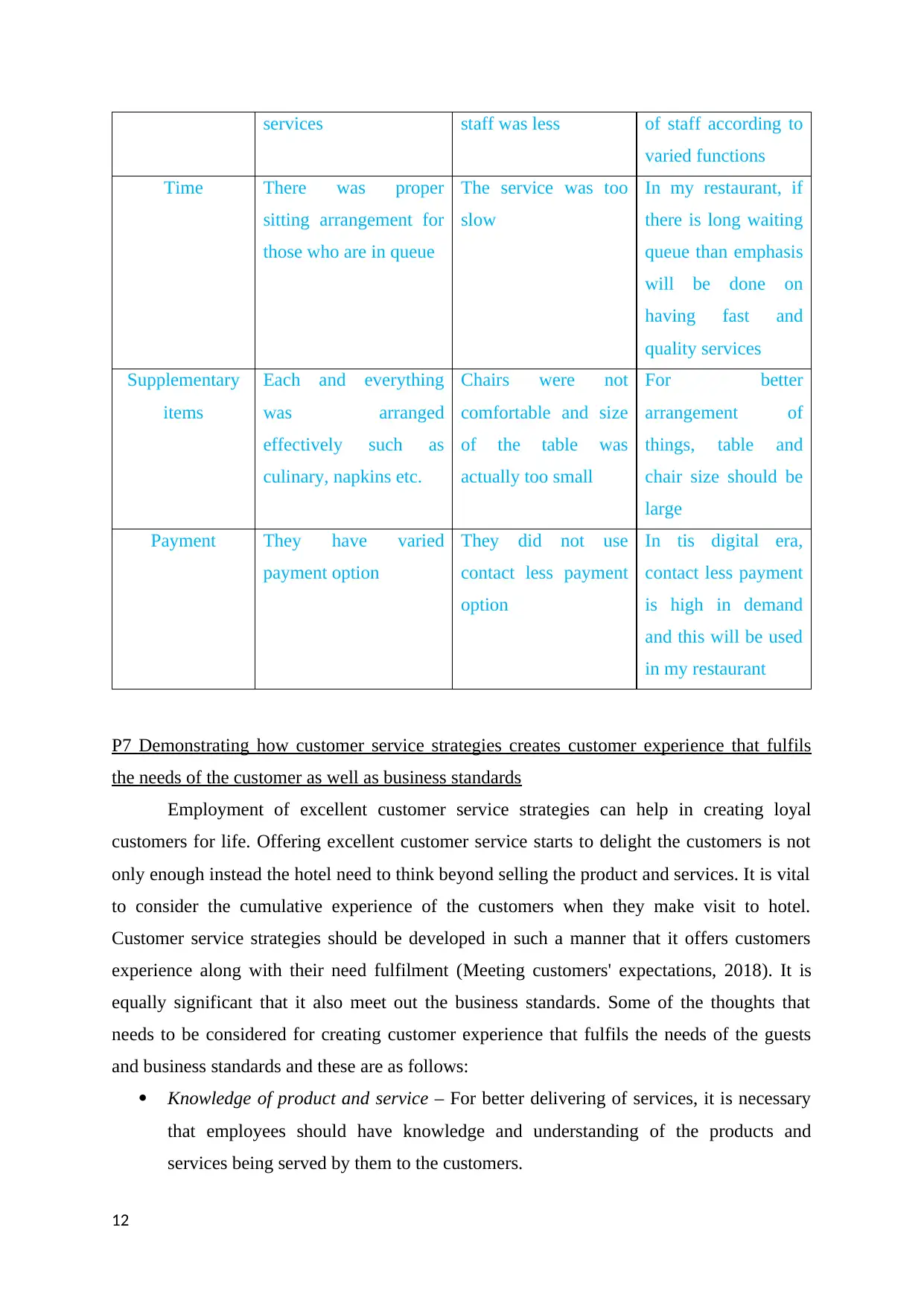
services staff was less of staff according to
varied functions
Time There was proper
sitting arrangement for
those who are in queue
The service was too
slow
In my restaurant, if
there is long waiting
queue than emphasis
will be done on
having fast and
quality services
Supplementary
items
Each and everything
was arranged
effectively such as
culinary, napkins etc.
Chairs were not
comfortable and size
of the table was
actually too small
For better
arrangement of
things, table and
chair size should be
large
Payment They have varied
payment option
They did not use
contact less payment
option
In tis digital era,
contact less payment
is high in demand
and this will be used
in my restaurant
P7 Demonstrating how customer service strategies creates customer experience that fulfils
the needs of the customer as well as business standards
Employment of excellent customer service strategies can help in creating loyal
customers for life. Offering excellent customer service starts to delight the customers is not
only enough instead the hotel need to think beyond selling the product and services. It is vital
to consider the cumulative experience of the customers when they make visit to hotel.
Customer service strategies should be developed in such a manner that it offers customers
experience along with their need fulfilment (Meeting customers' expectations, 2018). It is
equally significant that it also meet out the business standards. Some of the thoughts that
needs to be considered for creating customer experience that fulfils the needs of the guests
and business standards and these are as follows:
Knowledge of product and service – For better delivering of services, it is necessary
that employees should have knowledge and understanding of the products and
services being served by them to the customers.
12
varied functions
Time There was proper
sitting arrangement for
those who are in queue
The service was too
slow
In my restaurant, if
there is long waiting
queue than emphasis
will be done on
having fast and
quality services
Supplementary
items
Each and everything
was arranged
effectively such as
culinary, napkins etc.
Chairs were not
comfortable and size
of the table was
actually too small
For better
arrangement of
things, table and
chair size should be
large
Payment They have varied
payment option
They did not use
contact less payment
option
In tis digital era,
contact less payment
is high in demand
and this will be used
in my restaurant
P7 Demonstrating how customer service strategies creates customer experience that fulfils
the needs of the customer as well as business standards
Employment of excellent customer service strategies can help in creating loyal
customers for life. Offering excellent customer service starts to delight the customers is not
only enough instead the hotel need to think beyond selling the product and services. It is vital
to consider the cumulative experience of the customers when they make visit to hotel.
Customer service strategies should be developed in such a manner that it offers customers
experience along with their need fulfilment (Meeting customers' expectations, 2018). It is
equally significant that it also meet out the business standards. Some of the thoughts that
needs to be considered for creating customer experience that fulfils the needs of the guests
and business standards and these are as follows:
Knowledge of product and service – For better delivering of services, it is necessary
that employees should have knowledge and understanding of the products and
services being served by them to the customers.
12
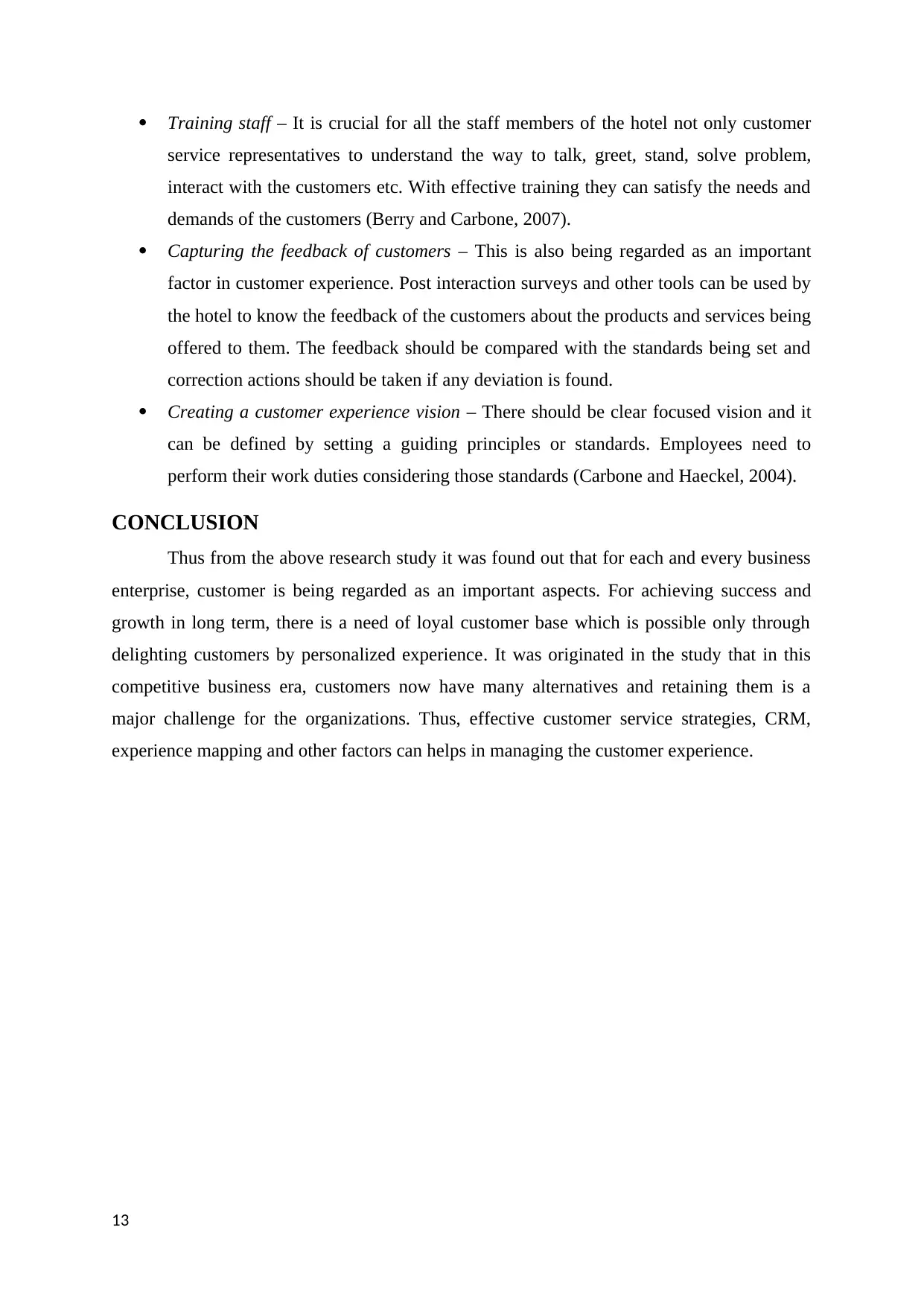
Training staff – It is crucial for all the staff members of the hotel not only customer
service representatives to understand the way to talk, greet, stand, solve problem,
interact with the customers etc. With effective training they can satisfy the needs and
demands of the customers (Berry and Carbone, 2007).
Capturing the feedback of customers – This is also being regarded as an important
factor in customer experience. Post interaction surveys and other tools can be used by
the hotel to know the feedback of the customers about the products and services being
offered to them. The feedback should be compared with the standards being set and
correction actions should be taken if any deviation is found.
Creating a customer experience vision – There should be clear focused vision and it
can be defined by setting a guiding principles or standards. Employees need to
perform their work duties considering those standards (Carbone and Haeckel, 2004).
CONCLUSION
Thus from the above research study it was found out that for each and every business
enterprise, customer is being regarded as an important aspects. For achieving success and
growth in long term, there is a need of loyal customer base which is possible only through
delighting customers by personalized experience. It was originated in the study that in this
competitive business era, customers now have many alternatives and retaining them is a
major challenge for the organizations. Thus, effective customer service strategies, CRM,
experience mapping and other factors can helps in managing the customer experience.
13
service representatives to understand the way to talk, greet, stand, solve problem,
interact with the customers etc. With effective training they can satisfy the needs and
demands of the customers (Berry and Carbone, 2007).
Capturing the feedback of customers – This is also being regarded as an important
factor in customer experience. Post interaction surveys and other tools can be used by
the hotel to know the feedback of the customers about the products and services being
offered to them. The feedback should be compared with the standards being set and
correction actions should be taken if any deviation is found.
Creating a customer experience vision – There should be clear focused vision and it
can be defined by setting a guiding principles or standards. Employees need to
perform their work duties considering those standards (Carbone and Haeckel, 2004).
CONCLUSION
Thus from the above research study it was found out that for each and every business
enterprise, customer is being regarded as an important aspects. For achieving success and
growth in long term, there is a need of loyal customer base which is possible only through
delighting customers by personalized experience. It was originated in the study that in this
competitive business era, customers now have many alternatives and retaining them is a
major challenge for the organizations. Thus, effective customer service strategies, CRM,
experience mapping and other factors can helps in managing the customer experience.
13
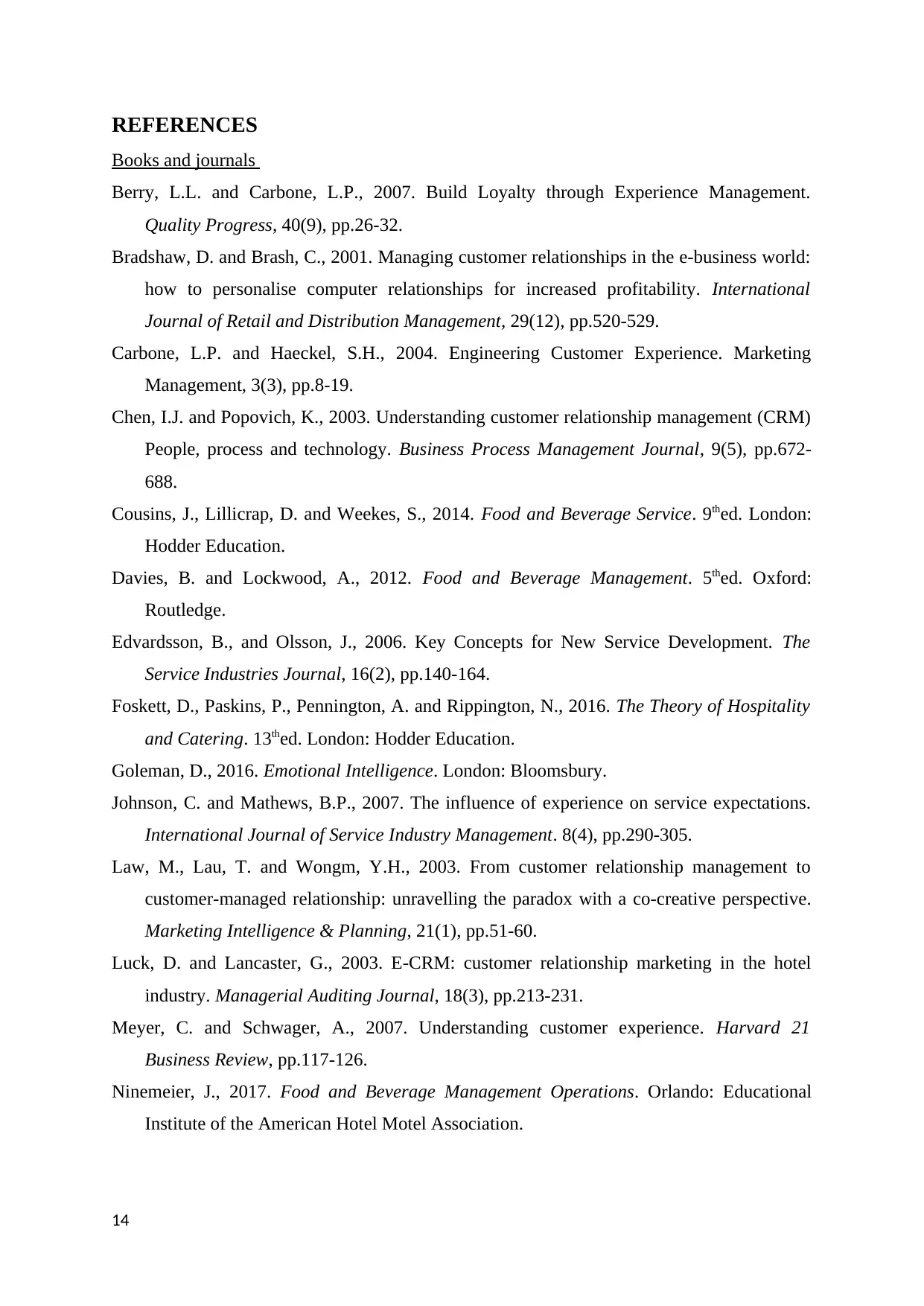
REFERENCES
Books and journals
Berry, L.L. and Carbone, L.P., 2007. Build Loyalty through Experience Management.
Quality Progress, 40(9), pp.26-32.
Bradshaw, D. and Brash, C., 2001. Managing customer relationships in the e-business world:
how to personalise computer relationships for increased profitability. International
Journal of Retail and Distribution Management, 29(12), pp.520-529.
Carbone, L.P. and Haeckel, S.H., 2004. Engineering Customer Experience. Marketing
Management, 3(3), pp.8-19.
Chen, I.J. and Popovich, K., 2003. Understanding customer relationship management (CRM)
People, process and technology. Business Process Management Journal, 9(5), pp.672-
688.
Cousins, J., Lillicrap, D. and Weekes, S., 2014. Food and Beverage Service. 9thed. London:
Hodder Education.
Davies, B. and Lockwood, A., 2012. Food and Beverage Management. 5thed. Oxford:
Routledge.
Edvardsson, B., and Olsson, J., 2006. Key Concepts for New Service Development. The
Service Industries Journal, 16(2), pp.140-164.
Foskett, D., Paskins, P., Pennington, A. and Rippington, N., 2016. The Theory of Hospitality
and Catering. 13thed. London: Hodder Education.
Goleman, D., 2016. Emotional Intelligence. London: Bloomsbury.
Johnson, C. and Mathews, B.P., 2007. The influence of experience on service expectations.
International Journal of Service Industry Management. 8(4), pp.290-305.
Law, M., Lau, T. and Wongm, Y.H., 2003. From customer relationship management to
customer-managed relationship: unravelling the paradox with a co-creative perspective.
Marketing Intelligence & Planning, 21(1), pp.51-60.
Luck, D. and Lancaster, G., 2003. E-CRM: customer relationship marketing in the hotel
industry. Managerial Auditing Journal, 18(3), pp.213-231.
Meyer, C. and Schwager, A., 2007. Understanding customer experience. Harvard 21
Business Review, pp.117-126.
Ninemeier, J., 2017. Food and Beverage Management Operations. Orlando: Educational
Institute of the American Hotel Motel Association.
14
Books and journals
Berry, L.L. and Carbone, L.P., 2007. Build Loyalty through Experience Management.
Quality Progress, 40(9), pp.26-32.
Bradshaw, D. and Brash, C., 2001. Managing customer relationships in the e-business world:
how to personalise computer relationships for increased profitability. International
Journal of Retail and Distribution Management, 29(12), pp.520-529.
Carbone, L.P. and Haeckel, S.H., 2004. Engineering Customer Experience. Marketing
Management, 3(3), pp.8-19.
Chen, I.J. and Popovich, K., 2003. Understanding customer relationship management (CRM)
People, process and technology. Business Process Management Journal, 9(5), pp.672-
688.
Cousins, J., Lillicrap, D. and Weekes, S., 2014. Food and Beverage Service. 9thed. London:
Hodder Education.
Davies, B. and Lockwood, A., 2012. Food and Beverage Management. 5thed. Oxford:
Routledge.
Edvardsson, B., and Olsson, J., 2006. Key Concepts for New Service Development. The
Service Industries Journal, 16(2), pp.140-164.
Foskett, D., Paskins, P., Pennington, A. and Rippington, N., 2016. The Theory of Hospitality
and Catering. 13thed. London: Hodder Education.
Goleman, D., 2016. Emotional Intelligence. London: Bloomsbury.
Johnson, C. and Mathews, B.P., 2007. The influence of experience on service expectations.
International Journal of Service Industry Management. 8(4), pp.290-305.
Law, M., Lau, T. and Wongm, Y.H., 2003. From customer relationship management to
customer-managed relationship: unravelling the paradox with a co-creative perspective.
Marketing Intelligence & Planning, 21(1), pp.51-60.
Luck, D. and Lancaster, G., 2003. E-CRM: customer relationship marketing in the hotel
industry. Managerial Auditing Journal, 18(3), pp.213-231.
Meyer, C. and Schwager, A., 2007. Understanding customer experience. Harvard 21
Business Review, pp.117-126.
Ninemeier, J., 2017. Food and Beverage Management Operations. Orlando: Educational
Institute of the American Hotel Motel Association.
14
Secure Best Marks with AI Grader
Need help grading? Try our AI Grader for instant feedback on your assignments.
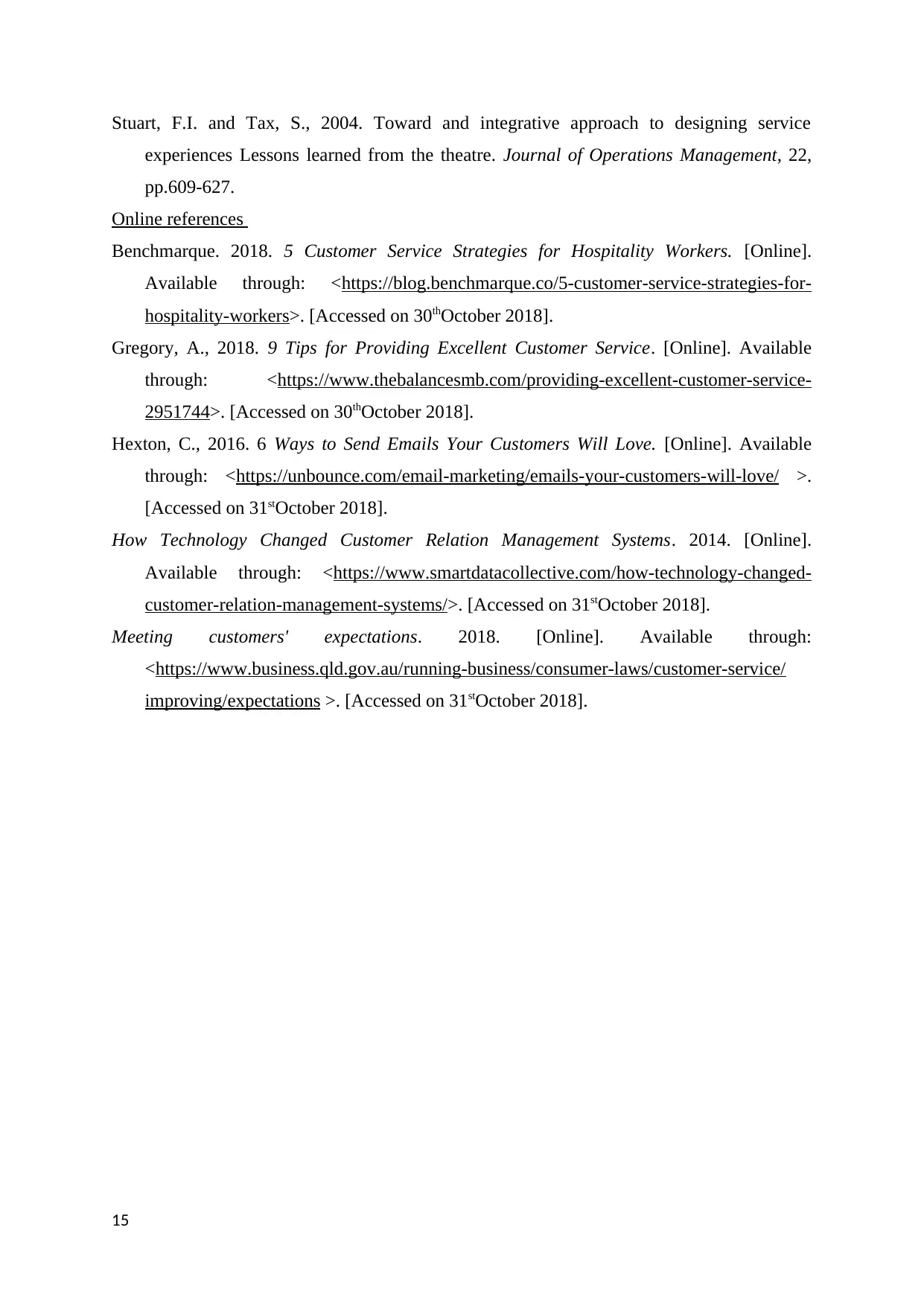
Stuart, F.I. and Tax, S., 2004. Toward and integrative approach to designing service
experiences Lessons learned from the theatre. Journal of Operations Management, 22,
pp.609-627.
Online references
Benchmarque. 2018. 5 Customer Service Strategies for Hospitality Workers. [Online].
Available through: <https://blog.benchmarque.co/5-customer-service-strategies-for-
hospitality-workers>. [Accessed on 30thOctober 2018].
Gregory, A., 2018. 9 Tips for Providing Excellent Customer Service. [Online]. Available
through: <https://www.thebalancesmb.com/providing-excellent-customer-service-
2951744>. [Accessed on 30thOctober 2018].
Hexton, C., 2016. 6 Ways to Send Emails Your Customers Will Love. [Online]. Available
through: <https://unbounce.com/email-marketing/emails-your-customers-will-love/ >.
[Accessed on 31stOctober 2018].
How Technology Changed Customer Relation Management Systems. 2014. [Online].
Available through: <https://www.smartdatacollective.com/how-technology-changed-
customer-relation-management-systems/>. [Accessed on 31stOctober 2018].
Meeting customers' expectations. 2018. [Online]. Available through:
<https://www.business.qld.gov.au/running-business/consumer-laws/customer-service/
improving/expectations >. [Accessed on 31stOctober 2018].
15
experiences Lessons learned from the theatre. Journal of Operations Management, 22,
pp.609-627.
Online references
Benchmarque. 2018. 5 Customer Service Strategies for Hospitality Workers. [Online].
Available through: <https://blog.benchmarque.co/5-customer-service-strategies-for-
hospitality-workers>. [Accessed on 30thOctober 2018].
Gregory, A., 2018. 9 Tips for Providing Excellent Customer Service. [Online]. Available
through: <https://www.thebalancesmb.com/providing-excellent-customer-service-
2951744>. [Accessed on 30thOctober 2018].
Hexton, C., 2016. 6 Ways to Send Emails Your Customers Will Love. [Online]. Available
through: <https://unbounce.com/email-marketing/emails-your-customers-will-love/ >.
[Accessed on 31stOctober 2018].
How Technology Changed Customer Relation Management Systems. 2014. [Online].
Available through: <https://www.smartdatacollective.com/how-technology-changed-
customer-relation-management-systems/>. [Accessed on 31stOctober 2018].
Meeting customers' expectations. 2018. [Online]. Available through:
<https://www.business.qld.gov.au/running-business/consumer-laws/customer-service/
improving/expectations >. [Accessed on 31stOctober 2018].
15
1 out of 17
Related Documents
Your All-in-One AI-Powered Toolkit for Academic Success.
+13062052269
info@desklib.com
Available 24*7 on WhatsApp / Email
![[object Object]](/_next/static/media/star-bottom.7253800d.svg)
Unlock your academic potential
© 2024 | Zucol Services PVT LTD | All rights reserved.





